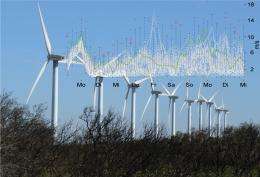Wayward winds - Predicting the output of wind parks

For the first time, scientists are comparing methods for predicting the power output of wind parks in Austria. The project, supported by the Austrian Science Fund FWF, thus creates a basis for optimised forecasts of wind park outputs - forecasts that can be used to make better decisions about which measures to take to ensure the need for power is met. The project focuses on forecasts for periods from six hours up to ten days. In addition to reliability, the temporal and spatial resolution of the different methods is analysed. The scientists also evaluate to what extent these methods are able to calculate the probability that these forecasts come true.
Natural energy sources are fickle. It is a problem that is manageable in hydropower, however the generation of electricity using wind or solar power is very sensitive to changes in the weather. These circumstances are made even more difficult by the growing proportion of "green electricity" in the total production of electricity. Indeed, electricity suppliers must be able to guarantee an agreed-upon supply despite this uncertainty in power generation. They therefore need accurate forecasting methods. A team at the University of Innsbruck, Austria has now begun to look for such methods for predicting power generation by wind parks in Austria.
Generating Data on Power Generation
Prof. Georg Mayr, head of the team at the Institute of Meteorology and Geophysics, comments on the study method: "Put simply, we test all methods to see how well they can establish the connection between two data sets. Weather forecasting data and data from several Austrian wind parks, which indicate the real output level under different wind conditions. The forecasting method which, based on data from the past, can calculate the real energy generation most accurately, is likely the best method for predicting future output."
Prof. Mayr’s team is now comparing new methods with those already published. In 2006, three methods proved particularly promising: the "logistic Gaussian regression", the "non-homologous Gaussian regression" and the "ensemble dressing". However, the drawback of all three methods is the large amount of input data that they require: data on atmospheric conditions from at least two years.
The method referred to as "analogous" is another approach: It means that a situation is found in the past, which matches the current situation (which serves as input data). Thanks to the knowledge of how the past situation affected the output, the output for the next six hours or up to ten days can be mathematically derived from the current situation.
Besides the reliability and the spatial and temporal resolution of the forecasts, Prof. Mayr is interested in the "probability", as he explains: "The ensemble dressing method can consider the probability that its own forecasts will be accurate. Also, variations in the initial scenario and the resulting impact on the prediction are calculated. If there are few discrepancies, the probability that the predicted outcome will occur is high; if there are large discrepancies, the probability is lower".
Terabytes & Megawatts
Of course, such calculations accumulate a considerable amount of data. Prof. Mayr has therefore already "forewarned" the central IT services at the University of Innsbruck that his group will be processing a few terabytes of data. This huge "number crunching" effort is well worth it: in the period from 2000 to 2007 alone, the global proportion of wind energy (in the total energy generation) increased by 500 %. At the same time, the energy market is being liberalised and prices are guided by supply and demand, or, more accurately, "scheduled supply and scheduled demand". It can therefore be said with great certainty that a good forecasting method from an FWF project will be worth a lot.
Provided by Austrian Science Fund

















